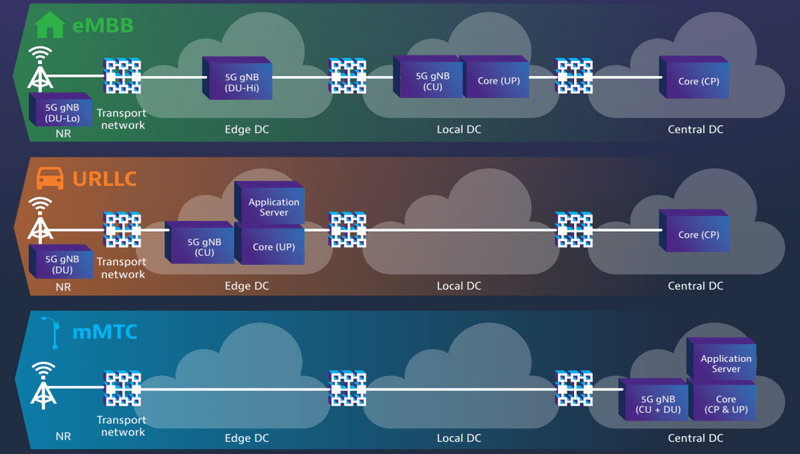What is 5G network slicing? How does it benefit industries?

What is 5G network slicing? How does it benefit industries?

Network slicing divides the network into multiple virtual connections that can be tailored to the traffic demands of different use cases. With 5G on the horizon, 5G network slicing has become an important focus. Network slicing is promoted as an essential capability of 5G. This article will help us understand 5G network slicing architecture and working principles, network slicing challenges and opportunities, the security of using slicing in 5G, and examples of 5G network slicing.
What is 5G network slicing?

The fifth-generation network has unique network slicing capabilities that previous generations of networks did not have. It is a function that allows service providers to deploy specific services to support the needs of different customers and market segments. Network slicing leverages network virtualization to divide a single network infrastructure into multiple virtual connections. These virtual connections can then be offered to businesses for customized benefits while ensuring compliance with service legal agreements (SLAs).
The main differentiators of this product are cost reduction, automation and flexibility. Network slices can be managed in such a way that they are dedicated to one or more customers. Slicing ensures that each connection has its own architecture, security, and management to support different use cases.
How does 5G network slicing work?
5G Cloud Native Network (5GCN) is a basic requirement for 5G network slicing. 5GCN is equipped with dedicated network nodes for network slicing. These network nodes are responsible for allocating wireless resources to devices according to service agreements.
5G networks need to adopt a service-based architecture. Adopting a service-based architecture is necessary to manage device and network resource allocation across the enterprise based on agreed upon service requirements.
To allow user equipment to connect to multiple slices, 5G networks consist of a large number of nodes specialized in network slicing. The master node performs the function of the network slice selection function (NSSF). In addition to this, the Access and Mobility Management Function (AMF) works in conjunction with the NSSF to determine the application of network slicing for each service agreement.
5G network slicing: architecture

eMBB, URLLC and mMTC
5G networks have the potential to meet diverse needs. These services are broadly divided into three categories:
- Enhanced Mobile Broadband (eMBB)
- Ultra-reliable and low-latency communications (uRLLC)
- Massive Machine Type Communications (mMTC)
The network slicing architecture in 5G requires network slicing software-defined network (SDN) and network function virtualization (NFV).
The role of SDN is to manage traffic through the application interface (API) of the central control plane. Through the application layer, the control plane configures resources to provide customized services on demand. The infrastructure layer is also a part of SDN, which contains basic network services and is responsible for data forwarding and rule processing from the control plane. The network slice controller (orchestrator) is responsible for mapping services and monitoring functions across layers.
SDN can create slices composed of specific resources. With the help of recursion, multiple child controllers can be created to support slice composition.
Another part of the architecture is network function virtualization. It allows the installation of network functions on virtual machines. NFV manages the lifecycle of network slices and infrastructure resources.
What is the meaning of network slicing?
While 5G is the next step in the evolution of mobile networks, it is not just another radio access network model thanks to network slicing. Network slicing operates by applying virtualization principles to mobile networks. While this may prove to be the next disruption in Industrial Revolution 4.0, the debate continues about the urgency and importance of network slicing. Before we dive into the pros and cons, let’s go over the basics.
The simplest way to describe network slicing is horizontal virtualization, with an approach that focuses on:
- 5G New Radio (NR) Network
- Software Defined Networking (SDN) Technology
- Network Functions Virtualization (NFV) Architecture
These create various self-sufficient network slices, facilitating communication service providers (CSPs) to isolate users, machines and uses that require different quality of service (QoS). The application of these parts can be extended to provide a personal virtual infrastructure for mobile network administrators, which can go a long way in enhancing services based on mobile virtual network operators.
Horizontal slicing provides cross-application and cross-service network division. Each horizontal slice has its own virtual resources that are separate from those used for different slices.
This makes horizontal network slicing different from contemporary network partitioning, also known as vertical slicing. In these cases, resources are not split up as much but allocated based on use cases.
What are the main disadvantages of 5G network slicing?
Although network slicing has great potential for 5G networks, there are certain obstacles. Although there is consensus on the key role of network slicing in 5G, its implementation procedures still need to be clarified.
Since 5G networks provide wireless connectivity, the radio access network (RAN) must be redesigned for network slicing. Network slicing is typically applied to the central network area of a 5G network and can be performed across RAN segments by combining resources. However, to make 5G network slicing feasible, multiple macro cells and small cells need to work together to meet various network slicing requirements.
There is a need to understand how to best enable point-to-point connections between machine controllers and radio devices by combining network slicing with NFV and SDN.
While the independence of deployed technologies may limit interference from network slicing, achieving point-to-point connectivity is a challenge when there are too many network slices.
As networks gradually transition to 5G, ensuring network slicing can work with emerging 5G technologies will require broad interoperability. Communication service providers and network operators must test interoperability extensively to ensure network slicing works as expected in 5G networks.
Industry experts need to agree on the best route to implementation, which will take some time. While 5G network slicing takes advantage of the intelligent use of standard radio resources, it requires advanced technology to ensure the isolation of these radio resources.
Security of 5G Network Slicing
Network slicing increases network complexity, creating security risks. Each network slice carries different traffic and therefore has unique security requirements. The scalability that can be achieved with slicing also opens the door to potential cyber threats. An attack on the central infrastructure may hinder multiple slices at the same time.
Another security challenge brought about by network slicing is data isolation. For operators, it will be a challenge for operators to protect information used on one network slice from being modified by another network slice on the same infrastructure.
SDN and NFV are also potential threat areas. An attacker can use SDN’s input buffers to analyze packet processing times. Security threats surrounding NFV include attacks on orchestration management systems, denial of service attacks, etc.
Close coordination between operators and enterprises is critical to maintaining secure communications across slices. This will ensure that user privacy is protected while maintaining service quality.
Example
Some use cases for 5G network slicing include:
Autonomous vehicles: Slicing will allow networks to be customized to match the infrastructure, technical and regulatory requirements of autonomous vehicles. Dedicated network slicing will help ensure excellent quality of service with sufficient network resources.
Gaming: Intense competitions and games require uninterrupted low-latency connections for a worry-free user experience. Network resources can be customized according to the traffic needs of gamers to ensure a rich gaming experience. A stable connection will help keep the gaming world competitive.
5G Surgery: Remote surgery is one of the breakthrough use cases of 5G, allowing doctors to control robotic arms to perform high-risk surgeries from anywhere in the world. But when it comes to matters of life and death, seamless connectivity is crucial. 5G network slicing ensures dedicated network resources for surgery.
Sports: The world of sports is changing with the introduction of new technologies to reimagine the fan experience. Smart stadiums are being built, and technologies such as holograms, augmented reality, and virtual reality are being used to transform the fan experience at home and in the stadium. The new technology, which provides dedicated slices for different stadiums, will take fan engagement to the next level.
IoT Slicing: IoT devices are being used in everything from smart cities, inventory management, and health monitoring to smart homes. The amount of data generated by these devices requires uninterrupted connectivity with minimal latency. Network slicing accomplishes this by providing the freedom to customize it to suit individual needs.
Frequently Asked Questions
What does network slicing mean?
The creation of multiple virtualized and logical networks on a common physical network architecture is called network slicing. Each slice can support different amounts of traffic by providing different amounts of network resources. Network slicing opens up a plethora of use cases. Network slicing modifies the entire network by abstracting, isolating, orchestrating, and separating logical network components.
What is 3GPP network slicing?
3GPP defines network slicing as: a network slice is regarded as a logical end-to-end network that can be dynamically created. The 16th edition of 3GPP TR21.916 focuses on the business model of network slicing.
Why is network slicing important?
For network operators, the return on investment of network operators is maximized. This occurs due to the efficient management and allocation of large-scale network resources. Network slicing, on the other hand, allows a large number of use cases to be adopted by customizing network resources to support specific needs.